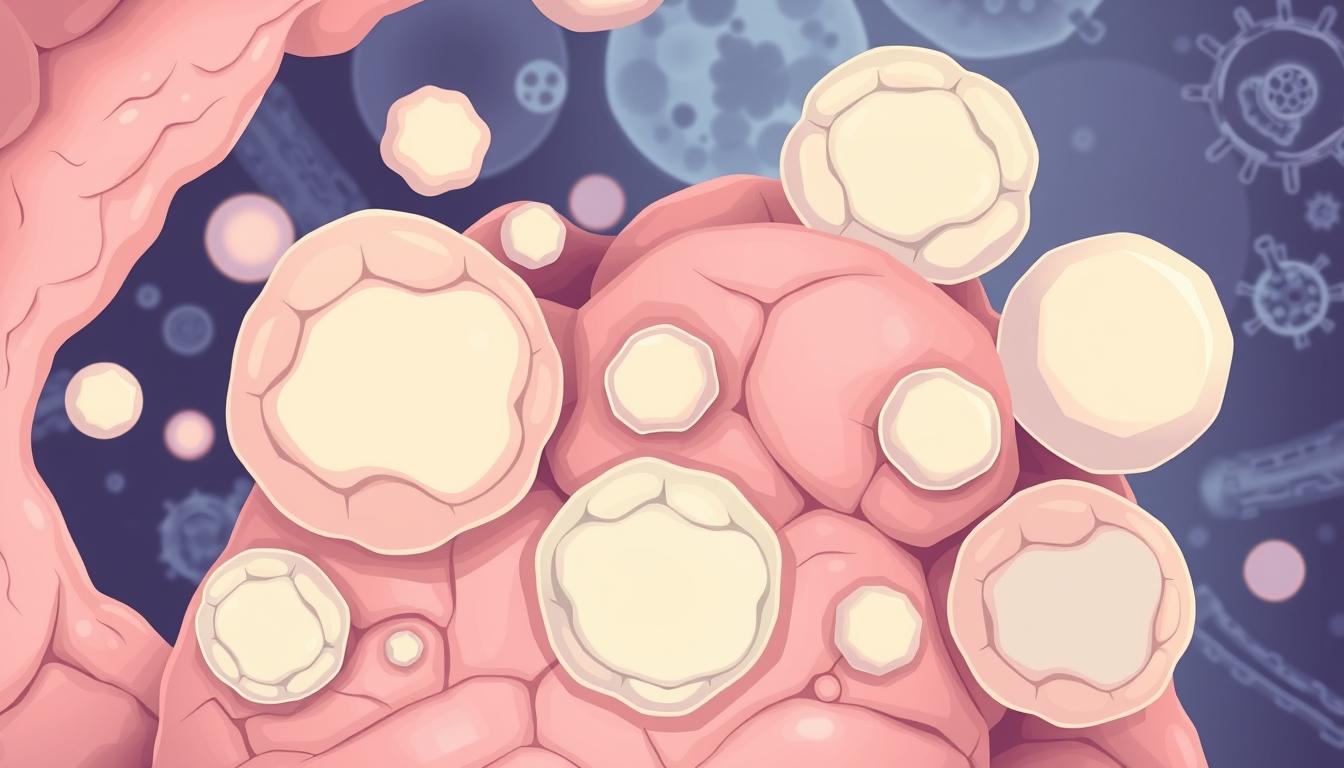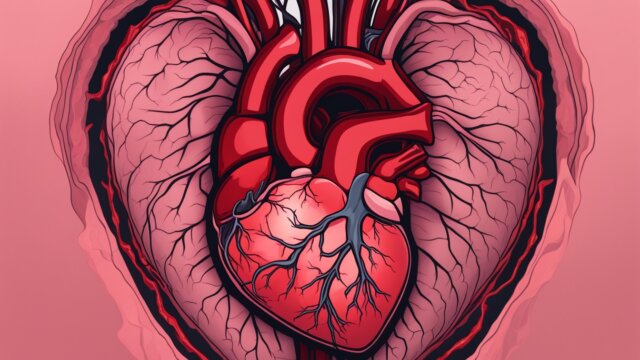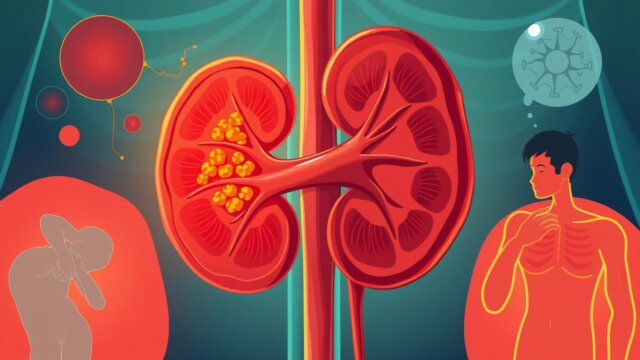FTC disclaimer: This post may contains affiliate links and we will be compensated if you click on a link and make a purchase.
Did you know that less than 1 out of every 10 adenomas in the colon become cancerous? This fact shows how important it is to know the difference between benign and malignant tumors. Benign tumors grow but don’t spread or invade like cancer does. About nine in 10 meningiomas, a brain tumor type, are benign.
This article will explain the causes, symptoms, and treatments of benign tumors. They are very different from cancerous ones.
Key Takeaways
- Benign tumors are abnormal growths that do not spread to other parts of the body.
- Lipomas are the most common type of benign tumor, often found in the neck, shoulders, back, or arms.
- Neurofibromas are more common in people with the inherited condition neurofibromatosis.
- Moles can continue to develop until around age 40, and some may be at higher risk of turning into melanoma.
- Benign tumors can sometimes cause problems if they press on vital structures, but in most cases, the outlook is very good.
What are Benign Tumors?
Benign tumors are noncancerous growths in the body. They don’t spread or invade nearby tissues. These tumors grow in one place and don’t spread.
While they can be dangerous if they press on vital organs, they are less threatening than cancerous tumors.
Difference Between Benign and Malignant Tumors
Benign and malignant tumors behave differently. Benign tumors have smooth borders and don’t grow into other tissues. Malignant tumors grow fast, have irregular borders, and can spread.
Benign tumors usually don’t come back after surgery, but malignant tumors might.
Benign Tumors | Malignant Tumors |
|---|---|
Do not spread to other parts of the body | Can spread to other parts of the body (metastasize) |
Grow slowly and have a distinct border | Grow rapidly and have an irregular border |
Usually, they do not recur after the removal | More likely to regrow after treatment |
Less threatening to overall health | More threatening to overall health |

Knowing the difference between benign and malignant tumors helps people understand their health better. This knowledge helps them make better choices about their treatment.
Common Types of Benign Tumors
Benign tumors are found in many forms. Each has its own traits and effects. The most common types are adenomas, lipomas, and fibroids (fibromas).
Adenomas
Adenomas start from gland or gland-like tissue. They can grow in many organs like the colon, liver, and thyroid gland. Usually, they don’t cause symptoms and might not need treatment right away. Still, it’s good to watch them for any changes.
Lipomas
Lipomas are common in adults, coming from fat cells. They often appear in the neck, shoulders, back, or arms. These soft lumps are usually painless and don’t need treatment unless they bother you or look bad.
Fibroids (Fibromas)
Fibroids are made of fibrous tissue. They can grow in many places, but mostly in the uterus. In the uterus, they can cause heavy bleeding, bladder issues, or pain. Up to 80% of women have them by age 50.
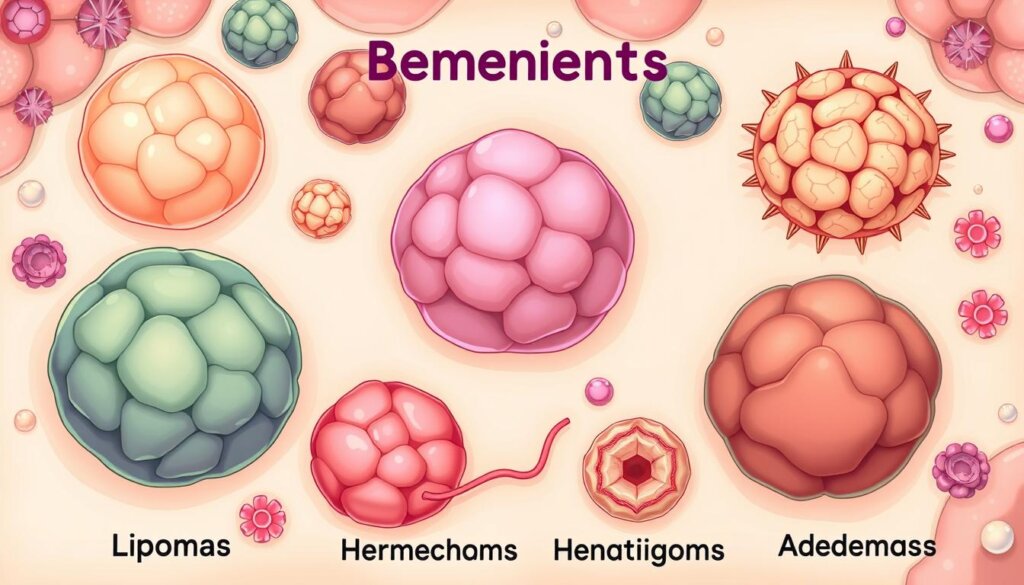
Knowing about benign tumors is key to spotting health issues early. While they’re not usually dangerous, it’s smart to keep an eye on them. If you notice any changes or symptoms, talk to a doctor.
Causes of Benign Tumors
Benign tumors grow because of cells that don’t stop dividing. Many things can start this growth, like toxins, radiation, and even stress. These tumors don’t spread or invade other tissues like cancer does.
Potential Risk Factors
Not all benign tumors have a known cause. But, some things can make you more likely to get them. These include:
- Exposure to toxins and radiation: Being around pollutants and radiation for a long time can mess with cell growth.
- Inflammation and infection: Long-lasting inflammation or infections can make cells grow abnormally.
- Genetics and family history: Some people might be more likely to get certain benign tumors because of their genes or family history.
- Diet and lifestyle factors: Eating poorly, drinking too much alcohol, and not moving enough can also lead to benign tumors.
Knowing about these risk factors can help you avoid benign tumors. If you notice any symptoms, see a doctor right away.

Symptoms of Benign Tumors
Benign tumors might not show symptoms right away. But, where they are can really affect your health. Depending on where the benign tumor is, it can cause symptoms like chills, pain, and fatigue.
Brain tumors can cause headaches and vision problems. They might also lead to seizures. Breast tumors can be felt as a bump. Bone tumors can cause pain and limit movement.
The symptoms of benign tumors vary a lot. This depends on where they are and what organ they affect. Regular check-ups and tests can find tumors early. This helps in treating symptoms quickly.
Tumor Type | Frequency | Common Symptoms |
|---|---|---|
Schwannoma | Most common benign peripheral nerve tumor in adults | Swelling, pain, tingling, numbness, weakness, loss of function |
Neurofibroma | Typically develops in people with neurofibromatosis 1 (NF1) | Swelling, pain, tingling, numbness, weakness, loss of function |
Perineurioma | Rare, more frequently affects children and young adults | Swelling, pain, tingling, numbness, weakness, loss of function |
Lipoma | Slow-growing, composed of fat cells, often appear under the skin | Asymptomatic unless pressing on a nerve |
Ganglion Cyst | Often located near joints, such as the wrist | Pain, interference with daily activities |
Most benign nerve tumors have no known cause. Some are hereditary. But, the good news is that most benign tumors are not cancerous. This means they are much less likely to turn into cancer.
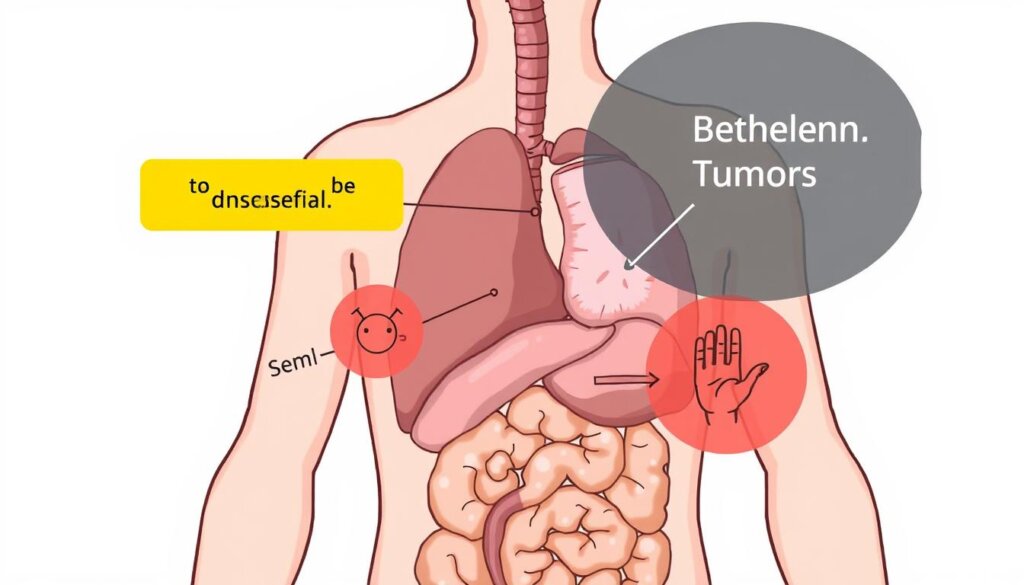
“Benign tumors can be tricky, as they may not always cause obvious symptoms. It’s important to be vigilant and get regular checkups to catch them early, when they’re often easier to manage.”
Knowing the symptoms of benign tumors can help you stay healthy. Their location and organ function matter a lot. Regular check-ups and tests are key to keeping you well.
Benign Tumors
Benign tumors grow from abnormal cells but don’t spread or invade other parts of the body. They might be painful or dangerous if they press on important organs. But they don’t threaten life like cancerous tumors do.
Some benign tumors, like fibroids in the uterus or hemangiomas, are quite common. Doctors can usually remove them surgically. And most of the time, they don’t come back after removal.
Malignant tumors, on the other hand, are cancerous and can spread throughout the body. They include carcinomas, sarcomas, germ cell tumors, and blastomas. Each type has its own treatment options.
The main differences between benign and malignant tumors are their growth patterns and how they need to be treated. A biopsy is often needed to tell them apart.
Benign Tumors | Malignant Tumors |
|---|---|
|
|
Benign tumors can be painful and risky, but they don’t spread like cancer does. They might need to be removed if they press on important areas. But most don’t come back after surgery.
For more info on benign tumors, check out the National Cancer Institute, American Cancer Society, and Mayo Clinic. There are also clinical trials looking into how to diagnose and treat them.
“Benign tumors are not cancerous and are characterized by abnormal growths in the body. They do not spread or invade other body parts but can be dangerous if they compress vital organs.”
Diagnosing Benign Tumors
Finding out if a tumor is benign or cancerous is key. Your doctor will start with a physical check-up and look at your health history. They will also do imaging tests and biopsies to learn more about the tumor.
Imaging Tests
Imaging tests are very important for diagnosing benign tumors. Your doctor might use CT scans, MRIs, mammograms, ultrasounds, or X-rays. These help see the tumor’s size, shape, and where it is.
High-frequency ultrasonography (over 20 MHz) is great for spotting lipomas. It gives clear pictures of tumors under the skin.
Biopsies
At times, a biopsy is needed to know if a tumor is benign or cancerous. A small piece of the tumor is taken and checked in a lab. This is often done for tumors inside the body that can’t be seen easily.
Your doctor might also do blood tests for cancer markers. These tests can give more hints about the tumor.
By using info from these tests, your doctor can tell if the tumor is benign. They can then plan the best treatment for you.
“Accurate diagnosis is the foundation for effective treatment of benign tumors.”
Treatment Options for Benign Tumors
Watchful Waiting vs. Surgical Removal
Managing benign tumors depends on the growth’s details. Not all benign tumors need immediate action. Doctors might watch them closely with regular check-ups and scans, called “watchful waiting.”
This method is common for noncancerous moles or colon polyps. They might turn cancerous but often don’t need treatment.
But, some benign tumors need surgery if they cause symptoms or press on important areas. The treatment plan varies based on the tumor’s type, size, and where it is. For small, clear lesions, endoscopic removal might work. For others, more serious surgery like pancreatoduodenectomy might be needed. Bleeding issues can be fixed with endoscopic fibrin glue injection.
Treatment Approach | Considerations |
|---|---|
Watchful Waiting | – Used for noncancerous growths that may not require immediate intervention – Involves regular monitoring through check-ups and imaging tests |
Surgical Removal | – Recommended for benign tumors causing symptoms or pressing on vital structures – Specific treatment plan depends on tumor type, size, and location – Options include endoscopic resection, pancreatoduodenectomy, and endoscopic fibrin glue injection |
Choosing a treatment for benign tumors is all about weighing risks and benefits. The aim is to manage the condition well without harming the patient’s health or quality of life. It’s crucial to keep up with follow-up appointments to watch for any changes or signs of cancer.
Living with a Benign Tumor
Living with a benign tumor can be worrying. But regular checks and talking to your doctor can help a lot. About 700,000 Americans live with brain tumors, and 80% are not cancerous. Even though they’re not deadly, they can still make you feel bad and affect your life.
Your doctor might suggest surgery and radiation therapy for treatment. Many people feel better soon after treatment. But there’s a chance the tumor could come back if it’s not fully removed. It’s important to keep up with imaging tests and doctor visits to watch the tumor.
Benign tumors grow slowly and don’t spread easily. But where and how big they are can still affect your day-to-day life. Symptoms like headaches, seizures, and weakness are common. Working on your symptoms and talking to your doctor can help you live better.
Remember, dealing with a benign tumor is a journey. Be kind to yourself and celebrate small health wins. With the right support, you can manage your condition and live a happy life.
Don’t forget, you’re not alone. Look for support groups and connect with others who face similar challenges. Sharing experiences and learning from each other can give you the strength to face any obstacle.
Prevention and Early Detection
There’s no sure way to stop all benign tumors, but you can help your health. Eating well, exercising, and managing stress can help. Also, regular health checks can find growth early, which is key for treatment.
Notice anybody changes and tell your doctor right away. This can help find tumors early.
Screening tests are checked for how well they work. They look at how many lives they save and the chance of finding cancers that won’t grow. It’s important to know the risks and costs of these tests.
Tests are judged by how well they catch cancer and how often they miss it. They also look at how many cancers are found that won’t cause problems.
The National Cancer Institute (NCI) has helped a lot in fighting cancer. They started programs to help find cancer early and prevent it. They also found that diet can help lower cancer risk.
They’ve done many studies to find the best ways to screen for cancer. They’ve looked at how diet and screening can help fight cancer.
Conclusion
Benign tumors may not be as dangerous as cancer, but they can still affect your health. Learning about the different types of benign tumors is important. It helps you manage them better.
Regular health checks and talking to your doctor are key. They help ensure you get the best care for benign tumors.
Bone cancers like Multiple Myeloma and Osteosarcoma are rare but serious. They affect a small number of people each year. Benign tumors in the mouth and face, like lipomas and hemangiomas, are also common.
Knowing about these tumors and their treatments is vital. It helps you deal with them and live well.
New research and treatments are making managing benign tumors better. This includes genetic studies and new medicines.
By using these new tools and working with your doctor, you can manage your condition well. This way, you can live a full and healthy life despite benign tumors.
FAQ
What are benign tumors?
Benign tumors are noncancerous growths that grow slowly. They don’t spread to other parts of the body. Unlike cancer, they don’t invade nearby tissue or spread.
How do benign tumors differ from malignant tumors?
Benign tumors have smooth borders and don’t grow into other tissue. Malignant tumors grow fast, have irregular borders, and can spread.
What are some common types of benign tumors?
Common types include adenomas, lipomas, and fibroids (fibromas).
What causes benign tumors?
The exact cause is often unknown. They grow when cells divide too much. This can be due to toxins, radiation, chemicals, or genetics.
What are the symptoms of benign tumors?
Symptoms vary by location. They can include chills, pain, fatigue, fever, and weight loss.
How are benign tumors diagnosed?
Doctors use exams, imaging tests, and blood tests to diagnose. Techniques include CT scans, MRIs, and biopsies.
What are the treatment options for benign tumors?
Not all need treatment right away. Some are watched closely. Others may need surgery if they cause symptoms.
How can I manage living with a benign tumor?
Regular check-ups are key. Your doctor will monitor the tumor. Open communication helps you understand and manage your tumor.
Can benign tumors be prevented?
No proven prevention exists. But, a healthy lifestyle and screenings can help. Being aware of body changes is also important.
